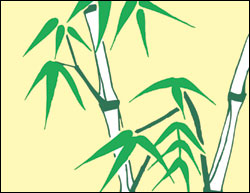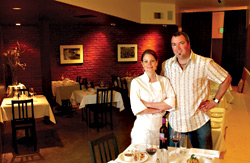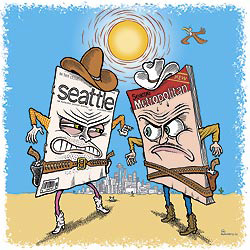FORGET DIAMONDS: Bamboo is forever. Bainbridge Island’s TimberGrass, which sells the stuff nationally, lauds the plant as “a structural building material in Asian cultures since the dawn of civilization.” More recently, the overgrown grass has become an ever-renewable commodity for ecologically conscious flooring, cabinetry, and furniture.
But what remains when we cut through the eco-hype (with a machete, preferably)? The Seattle area is home to two major players in the burgeoning bamboo biz: TimberGrass, a wholesale flooring and paneling enterprise, and Bamboo Hardwoods, a more retail-oriented business that produces furniture and furnishings in addition to floors.
According to TimberGrass, bamboo is “harder than oak” and “2.5 times more dimensionally stable than maple.” The material is also highly moisture-resistant and almost entirely termite-safe. The company’s Ann Knight claims the cost of bamboo flooring (around $6-$8 per square foot) is comparable to high-end hardwoods such as white oak and maple.
Bamboo Hardwoods’ David Keegan says that while his company began as a purveyor of “alternative wood products,” bamboo has more or less completed a 10-year transition from rarefied eco-novelty to mainstream design material. Last year, Bamboo Hardwoods installed more than 100 residential floors. It also sells ergonomic chairs and other made-for- suburbia furniture, including nesting stools and garden benches.
WHAT ACCOUNTS FOR bamboo’s sudden, er, growth? Knight emphasizes its unusual sustainability: Farmers can harvest the same plant, cycle after cycle (four to six years), with great ecological efficiency. Bamboo is famously the fastest-growing plant in the world, capable of sprouting 1 to 4 feet (!) in a day. Unlike those great swaths of clear-cut Douglas fir you glimpse from I-90, it doesn’t take decades to replenish itself. Forget the guilt of traditional forestry products; using bamboo is more like mowing your lawn.
According to Keegan, the bamboo plants surrounding his company’s Vietnam factory protect local rice paddies from adverse weather conditions. Furthermore, bamboo converts carbon dioxide to oxygen more quickly and completely than many other plants, and its use of soil nutrients is extremely resourceful.
Beyond flooring, TimberGrass is also pushing its versatile panels and veneers, which are produced with a relatively low-formaldehyde process (unlike most plywood). Bamboo comes in two primary shades, natural white and caramelized color (achieved through a heat treatment), which can then be stained.
Buyers should note, however, that bamboo can be tricky to install (particularly in our moist Northwest climate). Make sure your contractor has experience with the material, and that the hardest variety plant is usedpreferably “moso” (Phyllostachys pubescens). And no, it’s not the same type the pandas eat. So you don’t have to feel guilty about being green.









